For those who are just starting to learn knitting, there is a simple jacquard knitting pattern that can easily be used to decorate any item. When creating the pattern, yarn of different colors is used. There are both classic and modern jacquard patterns. Such patterns are suitable for decorating both adult and children's clothing.
What is a jacquard pattern and the features of its execution with knitting needles
A simple jacquard knitting pattern for beginners will help you master the basics of knitting using several colors of thread at the same time. In this case, the yarn is not cut when creating the fabric, and the interlacing of the threads is brought to the back side, where all the rough work is hidden.
The jacquard pattern is also called “multi-colored,” “warm,” or “embroidered with knitting needles.” This is due to the fact that experienced craftswomen often use cross stitch patterns in their work. They do the work in most cases with a garter stitch, and the main ornament appears on the outside.
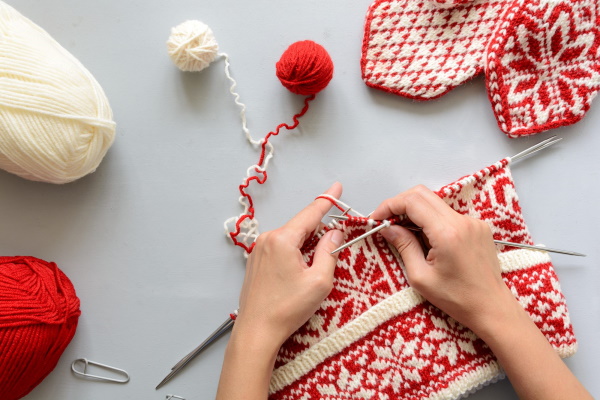
The name "Jacquard" itself appeared at the beginning of the 19th century in France and is associated with the inventor who created a weaving machine on which it was possible to create multi-colored fabrics. The difference between the new machine and the existing ones was that it wove fabrics with patterns, not alternating threads, but using all the necessary colors at the same time.
When describing the work of making all knitted patterns, generally accepted symbols and abbreviations are used to make it easier to write and read the pattern.
| Loop name | Abbreviation and designation |
| Facial | "LP" or "L" - "X" or "X-loop" |
| Purl | "ip" or "izn." — "-" |
| Edge | "krom." — "Ո" |
| Yarn over | "nak." - "+" |
Since multi-colored ornaments are usually made with a garter stitch, beginners should understand how to create them. To work in this style, knitting the front and back rows alternate. Externally, the loops of row 1 resemble a braided braid, and row 2 - convex waves.
The alternation of the repetition of a pattern on a fabric in knitting is called a "rapport". In the diagram, empty white cells usually indicate loops of the main color, and dark ones - elements of the ornament.
Also in knitting there is such a concept as “pulling through”. It denotes the location of the unused thread on the back side of the work, where it extends from the point where the color is stopped to the point where work with it is resumed.

To ensure that the broaches are uniform and do not sag, it is recommended to make them the same length as the number of loops in the background where the yarn was not used.
If the pattern is made without broaches, the threads of contrasting colors are intertwined with the working thread so that they do not interfere with the creation of the main fabric. In this case, the necessary color can always be extracted and used in the process of work when making the pattern.
What is the difference between making a jacquard pattern in rotary and circular rows?
A simple jacquard pattern, which is best suited for beginners, is knitted with both rotary and circular rows. The first option is possible on separate knitting needles, and the second - on those connected with a fishing line or "circular".
The difference in the rotary technique is that the craftswoman works alternately with both the front and back rows. The “shadow” side of the work is particularly difficult, as the interweaving of the threads makes it difficult to monitor the correct execution of the pattern.
In the rotary knitting style, loops are often used for symmetry, which also complicates the work on the ornament. Some craftswomen note that it is easier to create embroidery from yarn on circular knitting needles.
In this case, you don’t need to monitor the knitting of edge loops, and the process of creating the fabric itself takes place exclusively on the front side of the product, where the pattern is clearly visible and it is much easier to monitor the correctness of its execution.

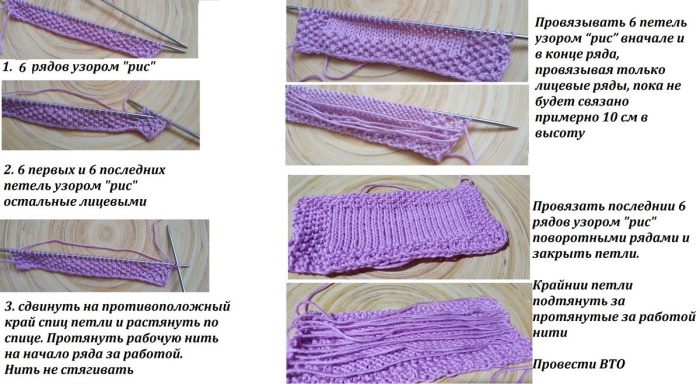
In addition, knitting is done only with facial loops, which also allows not to count the number of loops already created, and the pattern is repeated according to the rolled one. Working in this way, it will be easier for a novice needlewoman to notice a mistake and correct it in time.
Master classes on knitting jacquard patterns, patterns for beginners
A simple jacquard knitting pattern, which is easy for beginners to do, allows you to decorate warm mittens or a scarf. In addition, the ornament looks beautiful on a sweater, scarf, golf socks, house slippers or a skirt.
In order to achieve multi-colored embroidery with yarn, experienced needlewomen recommend:
- Select the right threads and knitting needles.
- Follow the recommendations of specialists.
- Practice creating a pattern.
Jacquard patterns are best made from yarns with the same thread diameter. In this case, the pattern looks uniform, and the background color smoothly transitions into the elements of the pattern.
To select a material, it is necessary to conduct several tests before purchasing. First, you need to feel the thread by holding it in your hands or placing it on your face or neck. This will help you understand how your body reacts to the touch of the material.
Secondly, you need to smell the skeins you like. The test will show how natural the yarn is. If the skein emits a subtle or obvious chemical smell, it is better to put it aside, since the composition of the fibers may be toxic, and the thing knitted from them may negatively affect health when worn for a long time.
Thirdly, the thread itself must consist of uniform fibers. To determine how and from what it is twisted, you need to examine its free end, which is easily removed from the skein. Having placed the thread between the thumb and index finger, you need to rub it lightly so that it allows you to examine the twist structure of the fibers.

If the thread has uneven thickenings and thinnings that are not related to its decorative properties, it is better to put the skein aside, since working with it may result in breaks in the fabric or the effect of a “floating” non-uniform pattern.
Experienced needlewomen recommend that novice craftswomen strictly follow the advice described in the pattern. This will make the work easier and speed up the process of creating the ornament. It will also help to avoid confusion in the work and mistakes when performing knitted embroidery.
Before you start working on the main piece, you need to practice on a small sample. To do this, it is recommended to cast on 10 to 30 stitches on the knitting needles and knit 1 pattern repeat to understand how to work on it and how it will look.
There are several simple multi-color patterns for beginners, and the most popular are:
- "Lazy";
- "Chicken foot";
- "Rose".
Each of the presented techniques allows a beginner to diversify the creation of a product and hone their skills in knitting with yarn of several colors.
Lazy
Lazy is considered one of the simplest techniques for making an ornament. For work you will need yarn of contrasting colors, for example, red and black. The first shade is suitable for the pattern, and the second - for the background.
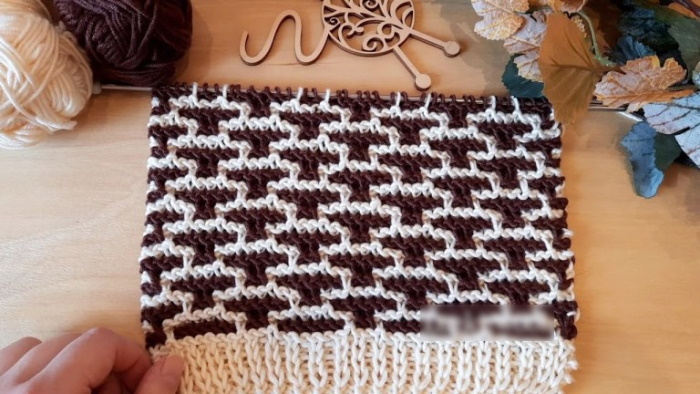
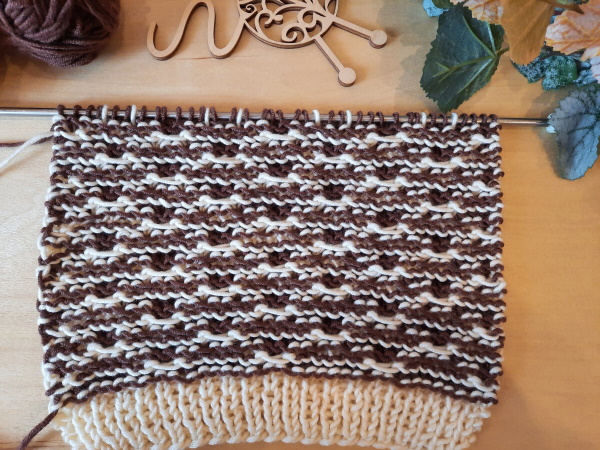
To complete the work, you need:
- Cast on an even number of stitches using black yarn.
- Knit row 1 with knit stitches only.
- Create row 2, like row 1, only with black thread, knitting only purl stitches.
- Insert 3 red thread into row. To do this, remove 1 black loop and knit 3 red front loops. Next, remove 1 loop and create 1 front loop also with red thread. Repeat the work to the end of the line.
- Knit 4 red “ears” in a row with the front red thread, and remove the black ones onto a pin or an additional knitting needle before work.
- Knit row 5 the same as row 1.
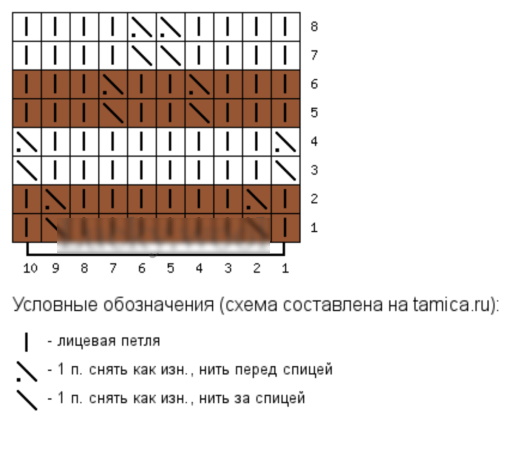
Experts note that when working with this technique, yarn consumption is minimized, which is also beneficial and convenient.
Chicken foot
A simple jacquard pattern with knitting needles for beginners can be made in the form of a chicken foot. The ornament looks beautiful on a skirt, vest or gloves. It is also sometimes used to decorate the border.
To obtain the pattern, you will need yarn of several colors, for example, white and brown. In this case, the light shade is used when knitting chicken feet, and the dark one is used as the main background.
To get the pattern you need:
- Start working by casting on the required number of loops in the main (brown) color. It is desirable that their total sum be divisible by 6. In this case, 2 edge loops are also taken into account.
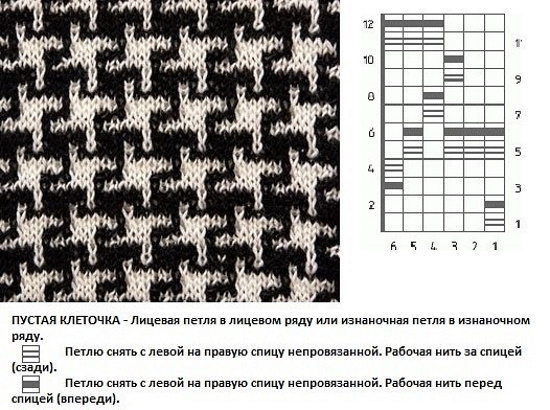
- Remove 1 brown "ear" in the row and place it behind the knitting. Then knit 5 loops with the front white thread. Work with the described technique to the end of the line.
- Knit row 2, alternating 5 white purl stitches and 1 slipped brown stitch.
- Make row 3 by knitting 5 brown knit stitches in turn and then slipping 1 white eye so that the yarn is behind the work.
- In row 4, slip the white stitch and then knit 5 brown purl stitches.
- Knit row 5, alternating slipping 3 brown ears, knitting white, slipped brown and 1 white knit.
- Work row 6, alternating knitting white purl, slipping brown, knitting purl in color in work and slipping next 3 stitches.
- Knit 3 white stitches after the edge stitch in row 7. Then remove the next stitch and form 2 brown stitches.
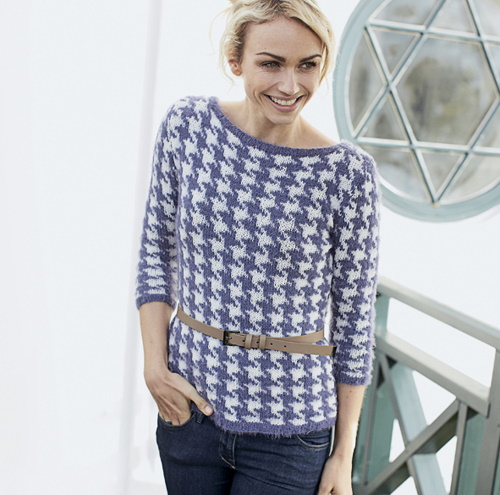 | 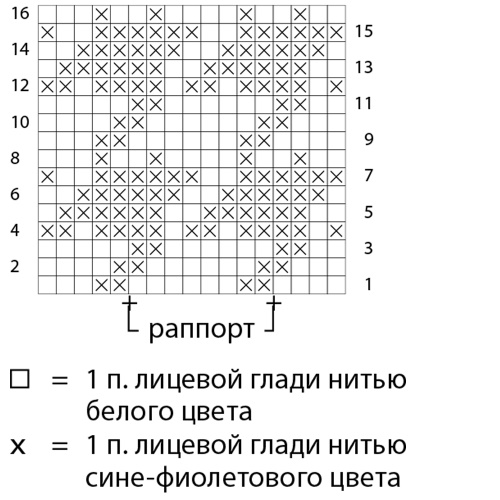 |
- Continue working, following the already formed pattern and alternating colors as the canvas suggests.
- Knit row 8, alternating 2 purl, 1 slip stitch and 3 purl.
- Create row 9, repeating alternately 2 knits, slip 1 stitch and 3 knits.
- Knit row 10 so that 3 purl alternate with removing the eyelet and 2 purl.
- Work row 11, alternating 3 knit stitches and 3 slipped stitches.
- In row 12, remove 3 loops, then knit 3 purl.
For some, this pattern resembles not only chicken feet, but also stars in the night sky.
Rose
You can decorate a vest, for example, with a rose pattern. The pattern is made with threads of 2 colors, or with 3 or more shades. A rose made of yarn is embroidered on the canvas, either as a single copy or alternating the flower through an equal section of the canvas.

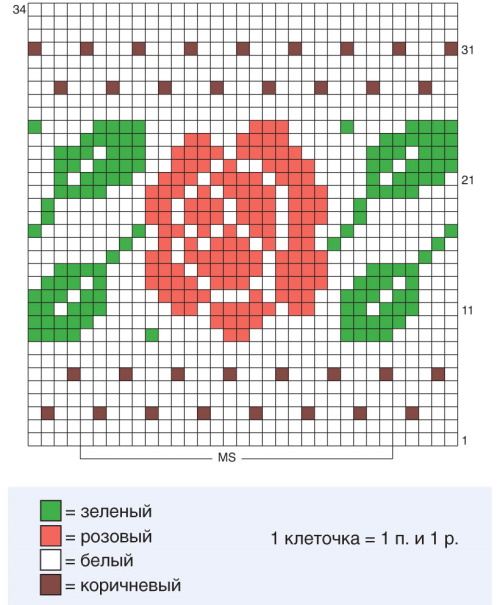
To create a pattern, beginners will need threads of white (background), green (stem and leaves) and red (bud) colors. To decorate the canvas with a rose, you need:
- Start by casting on the required number of stitches using the main white color.
- Knit row 1 with the main color.
- Create row 2, knitting 19 loops with purl white threads. Then introduce green, forming 4 purl loops from yarn. Then knit purl only with white color to the end of the line.
- Knit row 3, alternating 18 white knits with 6 green knits. Continue with white yarn to end of line.
- Create row 4, alternating purl 6 white, 3 green, 7 white and 6 green. Then knit only with white yarn to the end of the row.
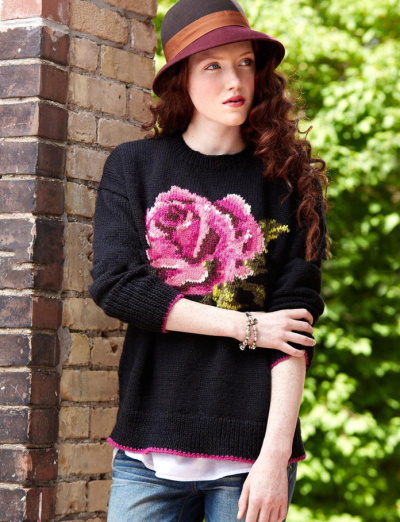 | 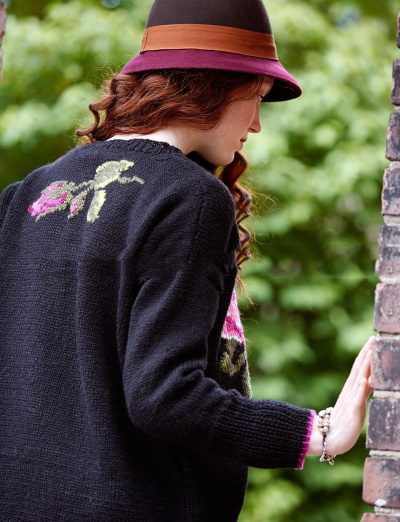 |
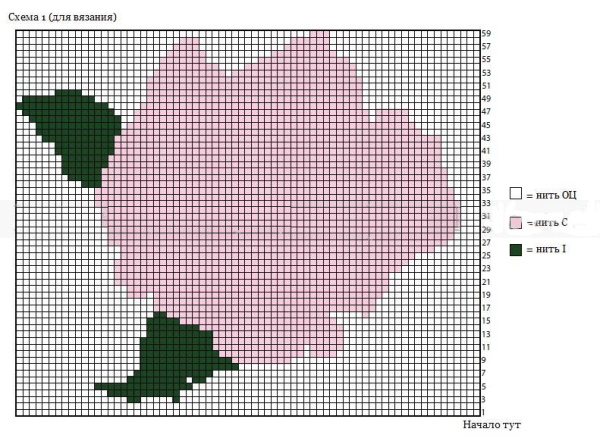 |  |
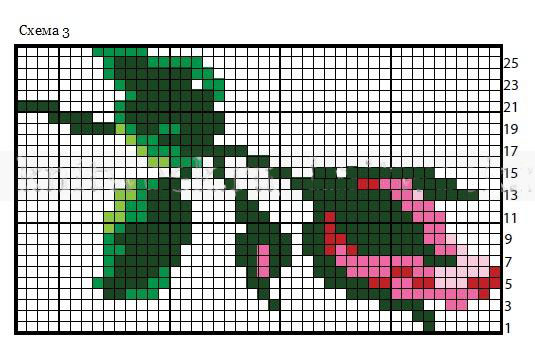 | |
- Knit row 5, creating 4 white, 2 green, 3 white and 1 green, 5 white, 6 green, 3 white and 2 red loops with the front ones. Then knit only white to the end of the strip.
- Create row 6, alternating purl stitches, where 1 white, 3 green, 6 white, 2 green, 3 white, 4 green, 3 white and 5 red. Then knit with the main color.
- Knit row 7, alternating colors in the following order: 13 white, 1 green, 3 white, 1 green, 4 white, 9 red and white.
- Purl row 8, alternating 12 white, green, 2 white, 2 green stitches. Then follow 11 red.
- Make row 9 in knits only, knitting 9 white, 4 green, 3 white, 1 green, 2 white and 11 red.
- Work row 10 with purl stitches, alternating 8 white, 5 green, 4 white, 2 green, 1 white and 11 red.
- Knit row 11 only with knit stitches, knitting 8 white, 5 green, 6 white, 1 green, 2 white, 8 red, 1 white and 1 red stitch.
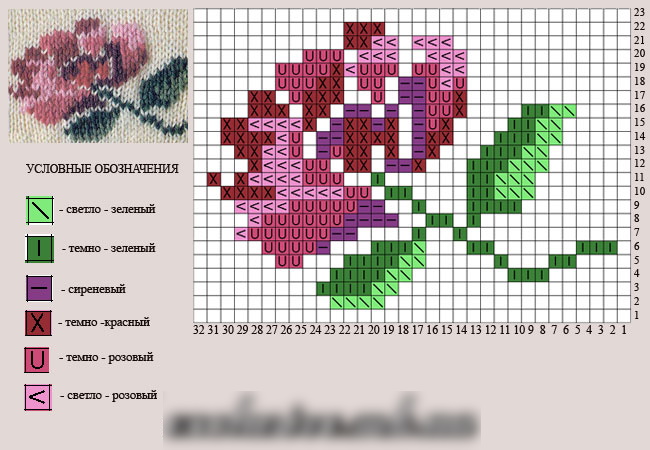
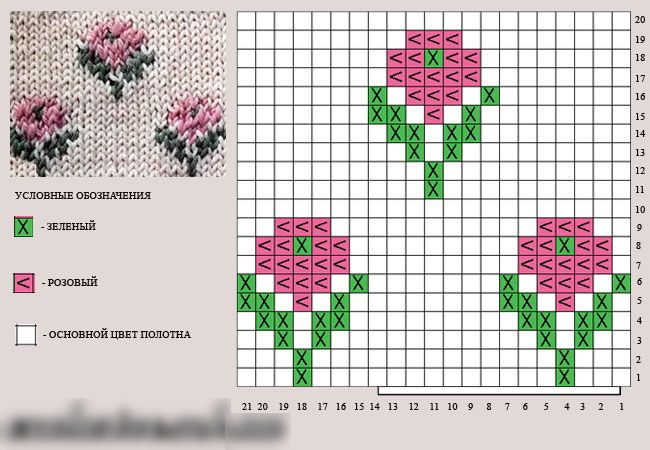
- Work row 12 following the stockinette stitch rules, alternating 7 white, 6 green, 3 white, 3 red, white, 2 red, white and 6 red stitches.
- Make a row of 13 stitches as the pattern suggests, alternating 7 white, 5 green, 3 white, 2 red, 1 white, red, white, 4 red, 1 white, 5 red.
- Knit row 14 purlwise, forming a rose from 5 white, 5 green, 3 white, 3 red, white, 6 red, white and 6 red loops.
- Make a row of 15 knit stitches, working 5 white, 4 green, 4 white, 3 red, white, 5 red, white and 7 red ears.
- Work row 16 purl stitches, creating a pattern of 4 white, 4 green, 4 white, 4 red, white, red, white, 2 red, white, 2 red, white and 3 red stitches.
- Knit row 17 following the stockinette stitch rule, alternating 13 white, 5 red, white, red, 2 white, 4 red, white and 2 red stitches.
- Work a row of 18 purl stitches, creating a pattern of 13 white, 5 red, white and 9 red ears.
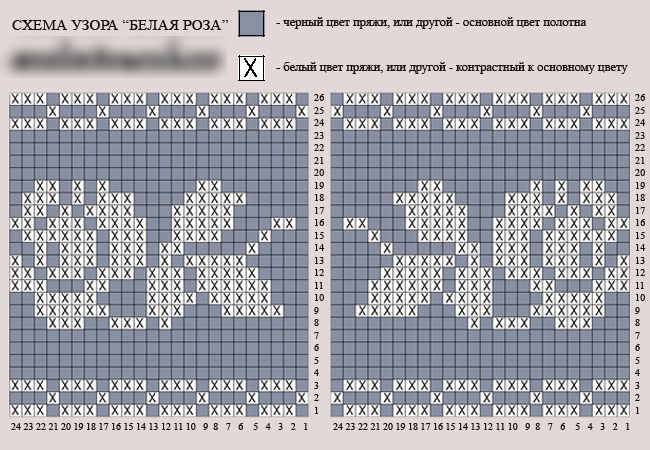
- Work row 19 as shown on the canvas, alternating 13 white, 4 red, white and 9 red stitches.
- Knit a row of 20 purl stitches, forming a pattern of 13 white, 3 red, 2 white, 3 red, white and 3 red ears.
- In the 21st row, knit 14 white, 3 red, 1 white and 4 red stitches.
- Finish the work on the ornament by knitting 19 white and 3 red loops in a row of 22 purl.
If desired, the body of the rose can be made one color, and the background another. Some craftswomen complement the main colors of the petals and bud with other suitable shades.
A simple jacquard pattern will allow beginners to improve their knitting skills. In addition, yarn embroidery allows you to show your imagination and create your own original patterns.
Video about the pattern
Simple jacquard knitting pattern:
